I included Mezőkövesd as a stop on my Hungarian road trip because I wanted to see for myself the birthplace of the famous Matyó floral embroidery. Travelling with my son, however, I couldn’t plan an entire itinerary focused only on embroidery, even though this colourful tradition has helped make Hungary known around the world. In this article, you’ll also discover the relaxing side of Mezőkövesd at the Zsóry Thermal Bath, as well as one of the largest agricultural machinery museums in Europe, an unmissable stop if you’re visiting with children.
Table of Contents
Where Is Mezőkövesd and Why Visit This Hidden Gem in Hungary
Mezőkövesd lies in the heart of northeastern Hungary and is the centre of the Matyó community, best known for its distinctive embroidery style, which is recognised as UNESCO Intangible Cultural Heritage. Visiting Mezőkövesd allows you to discover the strong sense of community identity, with its traditions passed down from one generation to the next. Here you can get a close look at how the Matyó people once lived and learn about the symbols and customs of a rural culture deeply intertwined with female creativity.
PLAN YOUR TRIP TO HUNGARY
For a road trip in Hungary, choose a Holafly eSIM: you will have unlimited internet to use Google Maps or any other GPS app, and you can share photos and videos in real time on WhatsApp and social media without any worries.
To travel with complete peace of mind, don’t forget to also take out Heymondo travel insurance, which protects you from unexpected events and ensures a worry-free holiday.
The Matyó Community: Discovering the Art of Traditional Hungarian Embroidery
One of the main cultural attractions in Mezőkövesd is the traditional embroidery and folk houses of the Matyó community, whose origins date back to the reign of King Matthias Corvinus in the 15th century. The vibrant folk culture, characterised by colour, craftsmanship, and unique costumes, as well as a deep Catholic faith, still permeates festivals and celebrations today.
The expressions of Matyó heritage include folk art, religious traditions, traditional crafts, dances and music. All these elements continue to be passed down through the generations, preserving a strong sense of identity that is renewed every day by those who live and share it.
Although no one lives today as families did 150 years ago (fortunately, as you’ll see at the Matyó Museum), the town hosts annual events such as the Matyó Easter Festival and the Zsóry Festival in July, where traditional costumes are proudly displayed. If you visit Mezőkövesd during these times, you can fully immerse yourself in local traditions and admire the splendid embroidered garments worn during the festivities.
Even outside the festivals, you can experience the beauty and authenticity of Matyó culture by visiting the Matyó Museum and the Hadas district, where traditional houses and artisan workshops still showcase the creativity of a community that has turned embroidery into art.
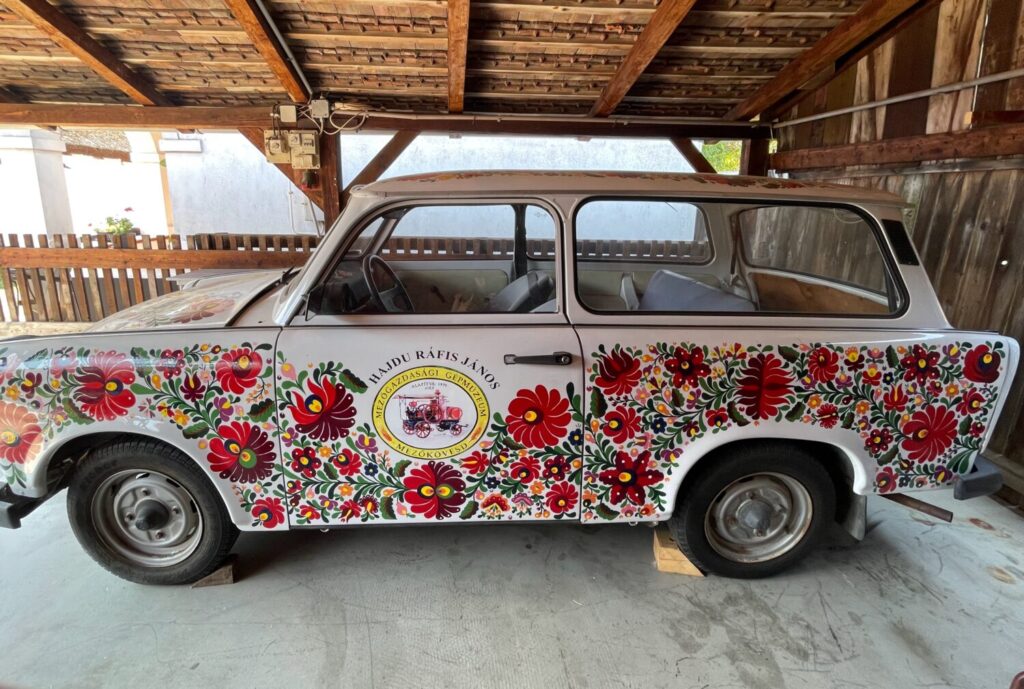
Who Are the Matyó People: History and Identity of a Unique Hungarian Culture
In the Matyó community, daily life revolved around the family and its traditions. People lived in large extended households with clearly defined roles and a strict domestic hierarchy. The home was the heart of social life, and marriage was one of the most important and spectacular events in the community.
A wedding was an opportunity for the family to display its wealth. Embroidered garments, decorated fabrics and wedding parades were all designed to impress and showcase the family’s prosperity.
Behind the beauty of the celebration, however, lay a life of sacrifice and duty. Arranged marriages were the norm, usually organised for economic rather than romantic reasons. Once married, a young woman moved into her husband’s home, where a hard life awaited her. She slept in a storage room and was responsible for all household chores as well as working in the fields.
Matyó Embroidery Explained: Colours, Symbols and the Meaning of This Living Folk Art
Recognised by UNESCO as Intangible Cultural Heritage, Matyó embroidery is one of the most captivating expressions of Hungarian folk art. Originating in the Catholic community of Mezőkövesd and the surrounding villages, it is characterised by floral motifs embroidered in satin stitch and by the richly coloured decoration of garments, fabrics and everyday objects.
According to legend, Matyó embroidery originated from a tale of love and cleverness. The devil kidnapped a Matyó girl’s fiancé, promising to return him only if she brought him the most beautiful flowers of summer. Since it was winter, the task seemed impossible. But the girl found a way to trick the devil: she embroidered an apron with magnificent flowers and won back her love. From that moment on, the floral motifs of Matyó embroidery became symbols of love, hope and creativity.
Matyó embroidery adorns the traditional costumes worn during festivals, dances and folk songs, representing a symbol of collective identity for the community. The colourful flowers, especially the Matyó rose, an emblem of beauty and pride, have become an integral part of Hungarian identity and continue to inspire fashion, design, and decoration today. At the Matyó Museum in Mezőkövesd, you can see how this embroidery has evolved while preserving its timeless charm and expressive power.
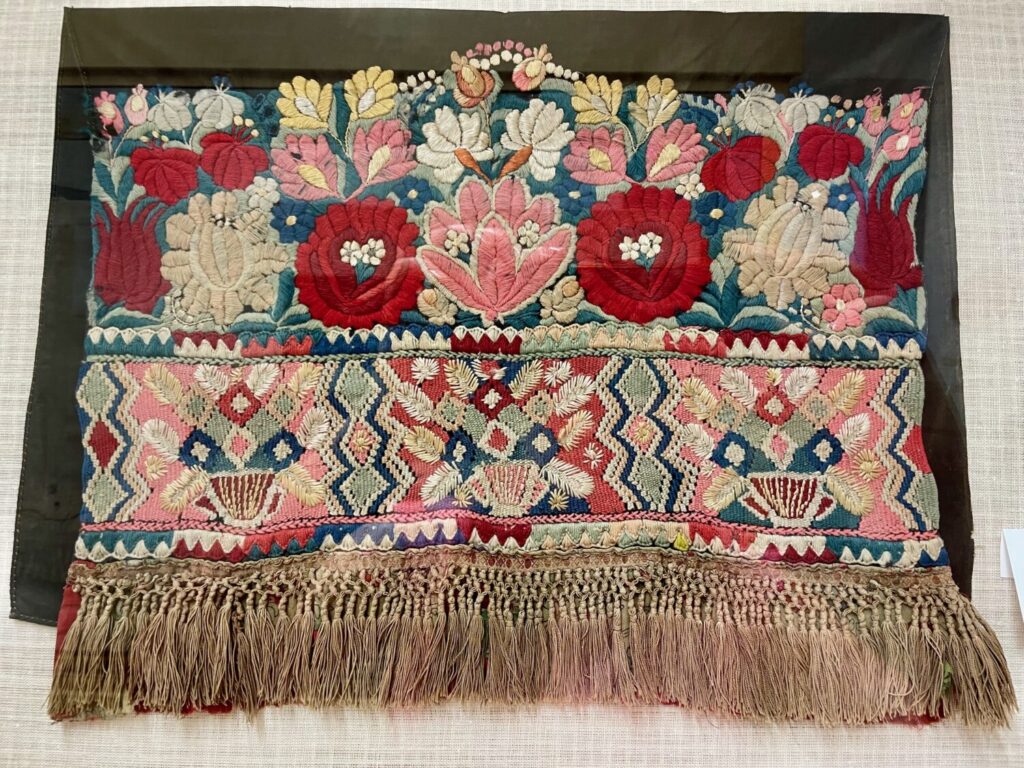
Top Things to See in Mezőkövesd: Museums, Traditional Houses and Thermal Baths
Although it is a small town, Mezőkövesd has plenty to see. We stayed for two days to take our time exploring the Matyó Museum, the traditional houses of the Hadas district, the Agricultural Machinery Museum, and the Zsóry Thermal Bath. My son would have happily spent all his time among the vintage tractors and engines at the Agricultural Machinery Museum. Still, unless you are just as passionate about tractors, there is much more to discover.
To start exploring Mezőkövesd, I recommend beginning at the Visitor Centre, located in the Hadas district. Inside the exhibition space, you can enjoy a lovely interactive display dedicated to the area and the traditional Matyó costumes, which is also great for children. One station takes a photo of you wearing the traditional headdress. At the same time, another lets you choose the clothes you would wear to a wedding.
In the Hadas district, you can freely enter several traditional houses where local artisans still practise their crafts. This part of Mezőkövesd is also home to the House of Bori Kisjankó, dedicated to the most famous designer of Matyó patterns, furnished in a traditional style.
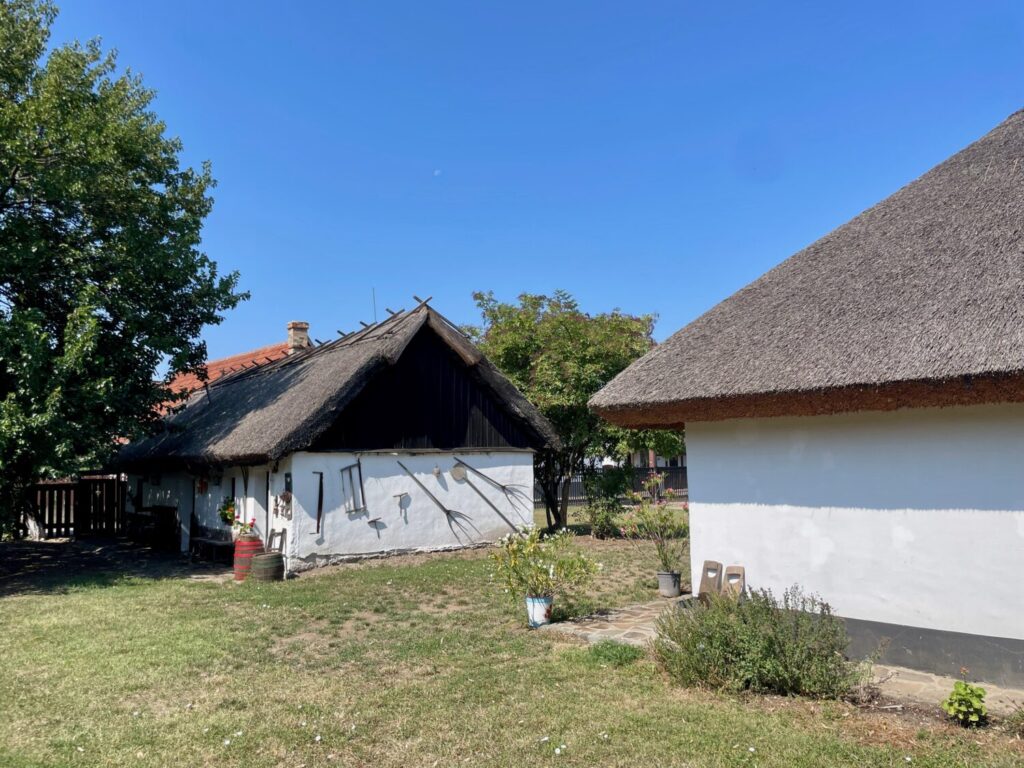
The Matyó Museum: Exploring Hungary’s UNESCO-Recognised Folk Heritage
The Matyó Museum is a must-visit destination on any trip to Mezőkövesd. It is, I believe, the only museum in Hungary entirely dedicated to this community. It doesn’t just focus on embroidery but also tells the story of how the Matyó community lived, through everyday objects, traditional garments and old photographs that bring the past to life.
Among the most fascinating pieces are the wedding parade costumes and the embroidered leather jackets. A rich selection of historical photographs shows people celebrating on festive days, offering an authentic glimpse into community life.
Inside the museum, you’ll also find a reconstructed traditional Matyó house, complete with original furniture and décor. The museum displays some of the finest examples of Matyó embroidery, recognised by UNESCO as Intangible Cultural Heritage, featuring beautifully embroidered textiles that show how this art has evolved while preserving its classic motifs, such as the famous százrózsás, literally the design with a hundred roses.
Matyó Múzeum Mezőkövesd
Szent László tér 8, 3400 Mezőkövesd
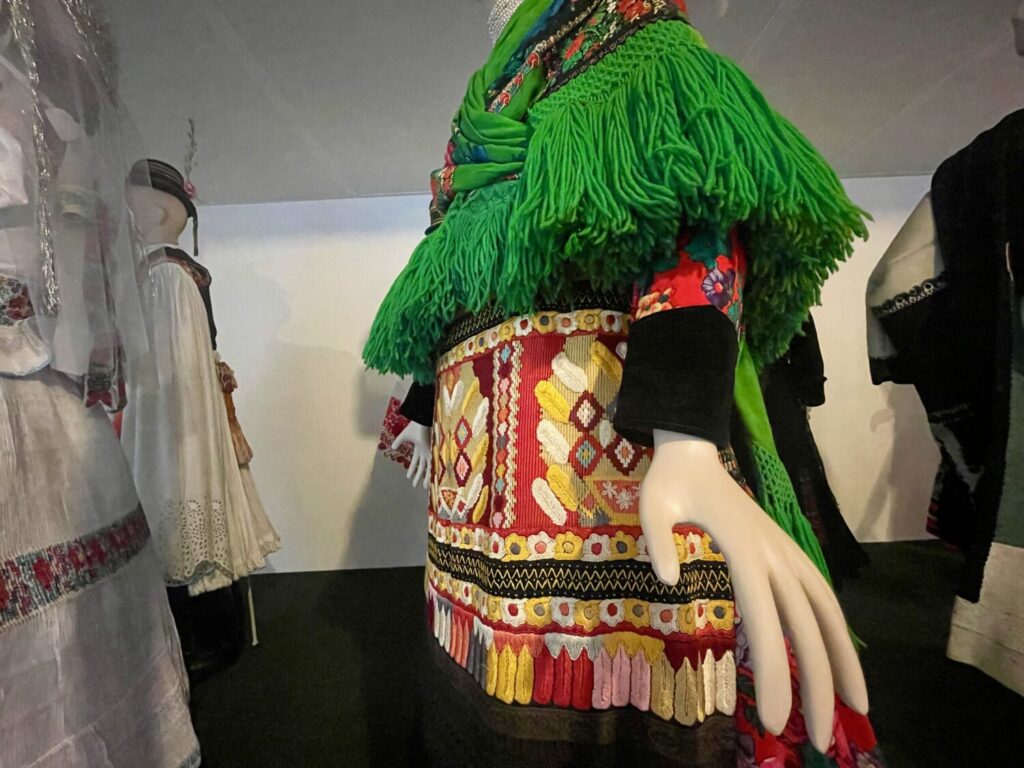
The Hadas District: Traditional Houses and Everyday Life in Mezőkövesd
The Hadas district lies just a short walk from the centre of Mezőkövesd. Here, you’ll find some of the town’s oldest houses. Its name comes from the Hungarian word had, meaning ‘army’, but in popular speech it also referred to an extended family group, much like a clan.
In northern Hungary, large extended families formed self-sufficient communities known as hadak. Each had represented a group of related families living in the same part of the village, and their names are on 19th-century maps of the town.
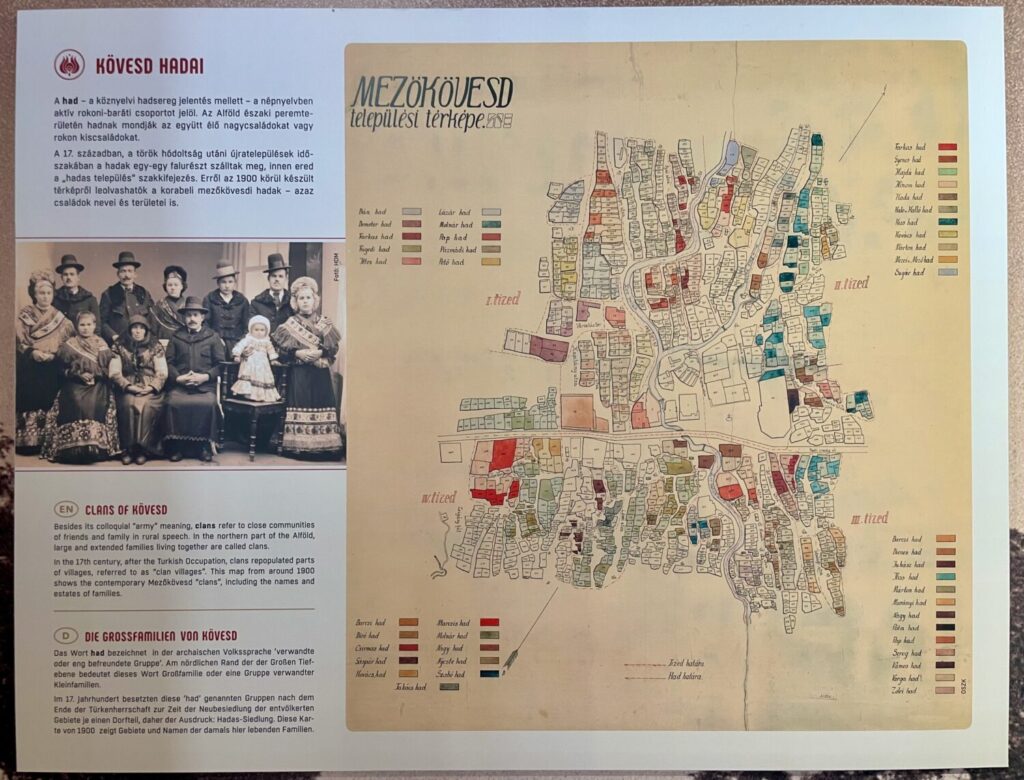
Inside the Mezőkövesd Visitor Centre, an interactive exhibition provides detailed information on how the Matyó community lived and what to see in the Hadas district. Children (and adults, too) will love the stations where you can take a photo wearing traditional Matyó headdresses, or play a game where you choose and match the right clothes to attend a wedding.
In the district, you can also enter several restored peasant houses, now open to the public. A unique feature of the local architecture is the so-called crested roof. To create this type of roof, you extend the roof beams and secure them to a central, slanted pole. Then, you tie a bundle of woven reeds to the pole as a symbol of protection for the home.
You can see something similar only in open-air ethnographic museums, such as the Skanzen in Szentendre. Still, in the Hadas district, everything is original. For children, exploring is both fun and educational.
Hadas Látogatóközpont
(Mezőkövesd Visitor Centre)
Kisjankó Bori u. 7, 3400 Mezőkövesd
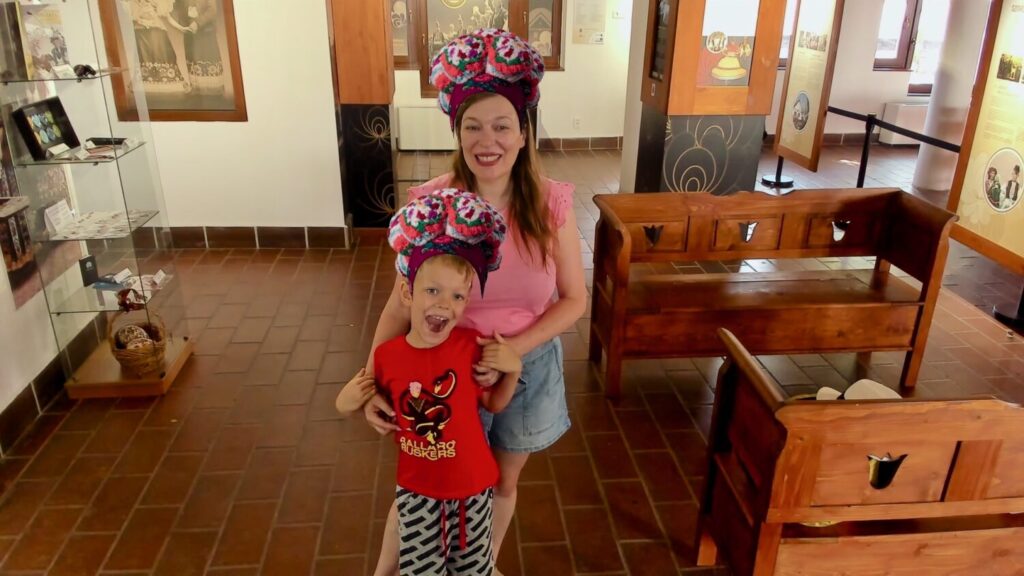
Bori Kisjankó Memorial House: Where Matyó Floral Patterns and Folk Creativity Were Born
At the Bori Kisjankó Memorial House, you can discover the story of one of the most important figures in Hungarian embroidery, recognised as a Master of Folk Art. Born in Mezőkövesd in 1876 and living there until her death in 1954, Bori Kisjankó is regarded as the main innovator of Matyó embroidery, which differs from the Kalocsa style in its denser and more intricate decorative patterns. She’s so famous that she has a statue in front of the Matyó Museum in Mezőkövesd.
Bori Kisjankó began by embroidering clothes and everyday household items. She soon became famous for her ability to design new floral patterns for other embroiderers in the village. Many variations of motifs featuring roses and flowers, especially with the famous Matyó rose, are attributed to her.
Bori’s work helped make Matyó embroidery famous throughout Hungary and even led to its presentation at the Millennium Exhibition in Budapest in 1896. Her designs are still a recognised symbol of this rich artisanal and cultural tradition.
Her house became a memorial museum in 1963, and there you can see how a typical family lived at the end of the 19th century. In the kitchen, there is a fireplace and a wooden bench used to store dishes and utensils. In the main room, you’ll find a high bed, a symbol of wealth, and a masonry stove. The pantry served as the young bride’s room, where she lived with her personal belongings until her mother-in-law’s passing.
Kis Jankó Bori Emlékház Mezőkövesd
(Bori Kisjankó Memorial House)
Kisjankó Bori u. 24, 3400 Mezőkövesd
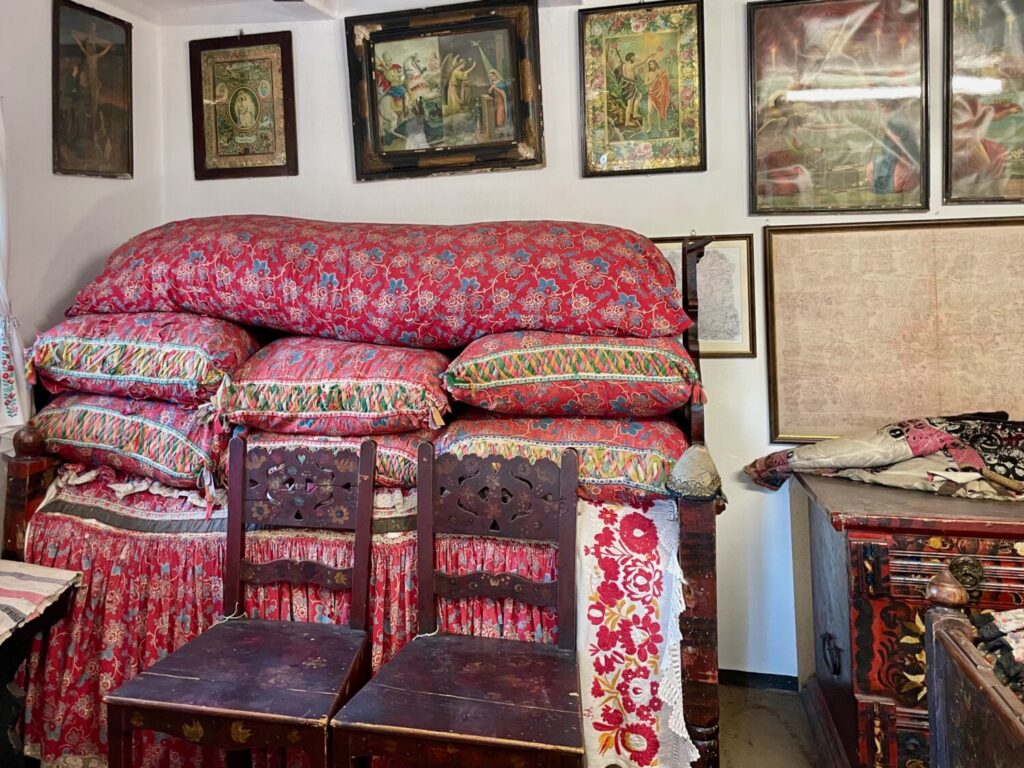
The István Takács Collection: Folk Traditions Through Hungarian Art
István Takács is the most important Hungarian fresco painter of the 20th century. His works decorate almost 300 churches across the country, including the frescoes of St Ladislaus Church in Mezőkövesd and the paintings depicting the Stations of the Cross in the Basilica of Eger.
The István Takács Collection, dedicated to his life and work, features over 250 pieces spread across twelve rooms. You can see landscapes, portraits, scenes of everyday life, and even fashion sketches, ranging from small drawings to large preparatory cartoons that are up to five metres long.
Takács’s art also plays an important role in preserving the Matyó tradition, as he loved to portray folk costumes and rural life from his homeland. Through his paintings, we can appreciate not only his artistic mastery but also a precious portrayal of the culture and identity of Mezőkövesd in the last century.
Takács István Gyűjtemény Mezőkövesd
(Collezione István Takács)
Szent László tér 23, 3400 Mezőkövesd
The Mezőkövesd Agricultural Machinery Museum: A Family-Friendly Open-Air Experience
Unique in Central Europe, the Mezőkövesd Agricultural Machinery Museum is a vast open-air museum spanning 5,000 square metres, featuring an impressive collection that ranges from the first stationary engines to the modern tractors used in fields today.
A visit here isn’t just for machinery enthusiasts; it’s a truly fun experience for the whole family. For my son, this was by far the best museum in Mezőkövesd, as children can explore it while riding small pedal tractors.
For adults, it’s equally fascinating thanks to the sheer number of tractors, threshers and agricultural machines on display. I had never seen so many all in one place! There are even agrarian locomotives, a type of machine I had never even heard of. You can read more about everything there is to see in my detailed article about the Mezőkövesd Agricultural Machinery Museum.
Hajdu Ráfis János Mezőgazdasági Gépmúzeum
(Mezőkövesd Agricultural Machinery Museum)
Eötvös utca 32, 3400 Mezőkövesd
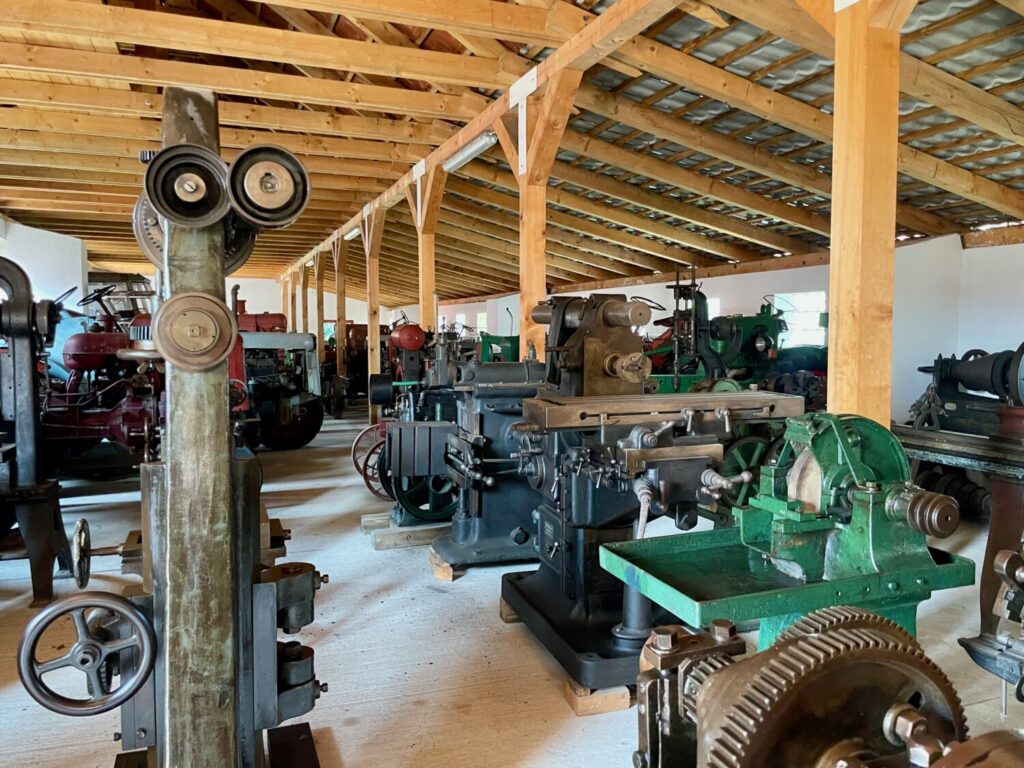
Zsóry Thermal Baths: Wellness, Spa and Relaxation in Mezőkövesd
A dip in the Zsóry Thermal Bath is a perfect activity at any time of year. The 60°C thermal waters of Zsóry are among the richest in sulphur in all of Hungary and are well known for their benefits in treating joint and muscle conditions.
The spa offers spaces for the whole family: little ones can play in the shallow and children’s pools, while adults can enjoy the hot thermal water or relax along the wellness paths. My son and I spent a wonderful day moving between the indoor and outdoor pools, relaxing and having fun together.
There are also wave pools, whirlpools, slides and swimming lanes, making it a place that truly suits everyone, as you can read in my dedicated article on the Zsóry Thermal Bath. The atmosphere is friendly and welcoming, making it the perfect setting for experiencing an authentic Hungarian thermal spa.
Zsóry Gyógy és Strandfürdő
(Zsóry Thermal Bath)
Napfürdő út 2, 3400 Mezőkövesd
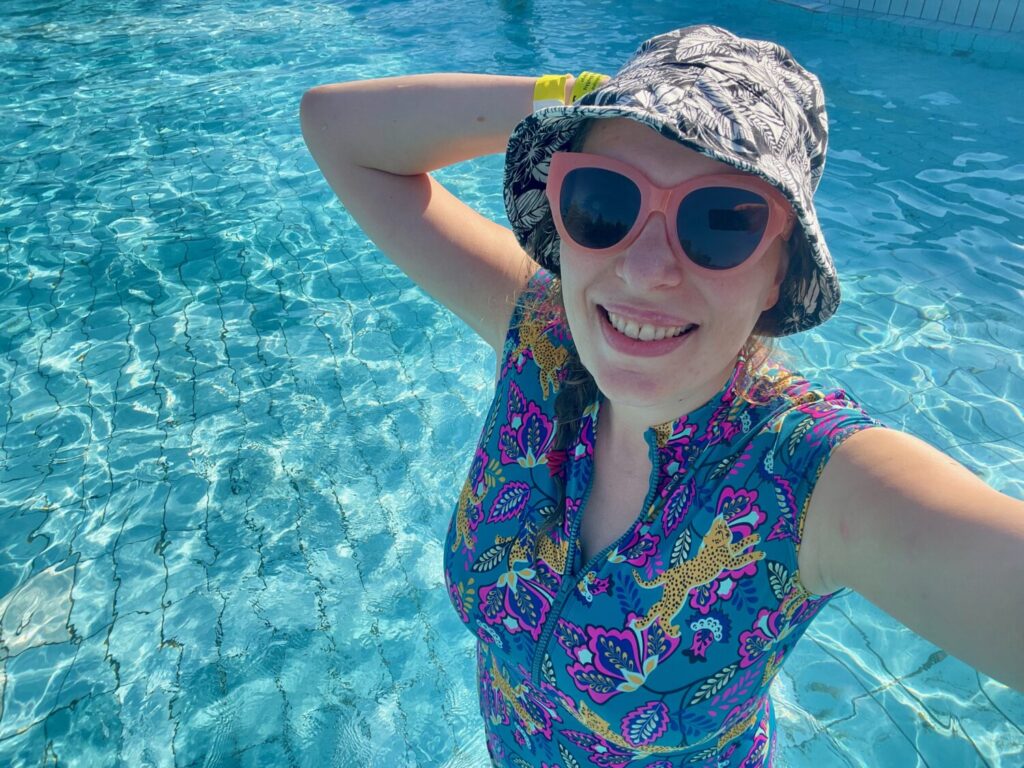
Practical Travel Tips for Visiting Mezőkövesd and Experiencing Matyó Culture
You can visit the main attractions of Mezőkövesd on a day trip from Budapest. Still, to really appreciate the town’s atmosphere, I recommend staying at least two days. This way, you can take your time exploring the museums, strolling through the traditional houses of the Hadas district, and spending at least half a day at the Zsóry Thermal Bath to relax and experience authentic Hungarian spa culture.
Visiting Mezőkövesd during one of its festivals, whether agricultural events or traditional celebrations, is an especially memorable experience. However, even outside these occasions, the town retains an authentic charm that is sure to win you over.
The museums showcase Matyó culture clearly and engagingly, while the town itself is ideal for families. Mezőkövesd is a quiet and safe city. During our summer visit, we also enjoyed visiting the Zsóry Thermal Bath, which is perfect for relaxing after a day of sightseeing. It’s a simple and welcoming destination, great for anyone looking to experience a genuine, less touristy side of Hungary.
What to Buy in Mezőkövesd: Matyó Embroidery Souvenirs and Local Crafts
If you want to take home a piece of Matyó culture, Mezőkövesd is the perfect place to shop for authentic embroidered souvenirs. Prices vary widely depending on the craftsmanship and the type of product. A beautifully hand-embroidered Matyó cushion can cost around €140–150, while a stunning modern ceremonial jacket with traditional embroidery may reach €230.
For something more affordable, you can find Matyó-style T-shirts decorated with smaller embroidered motifs starting from about €25. The most beautiful ones are made by the local brand Matyodesign, which combines traditional embroidery with modern fashion. If you miss your chance to buy Matyó souvenirs in Mezőkövesd, you can also find Matyodesign items in Budapest, although only in a few select shops.
Shops selling traditional embroidery in Mezőkövesd are quite few, and opening hours are limited, so it’s best to plan your visit in advance. During my stay, I only found a few proper souvenir shops, and one of them was closed. Despite this, browsing these small boutiques is a wonderful way to appreciate the artistry and patience behind Matyó embroidery and to bring home a truly unique souvenir from Mezőkövesd.
How to Get to Mezőkövesd and Travel Around the Town
If you’re driving from Budapest, you can take the M3 motorway all the way to Mezőkövesd. The journey takes around an hour and a half, and there are several rest areas and service stations along the route. During our stay, we always left the car in the private parking area of our apartment and explored the town centre on foot, which is compact and easy to get around. You’ll only need the car to reach the Zsóry Thermal Bath, located just outside town.
If you prefer to travel by train, there are direct connections from Budapest that also take about an hour and a half to reach Mezőkövesd. From the train station, you can walk to the town centre in roughly 20 minutes.
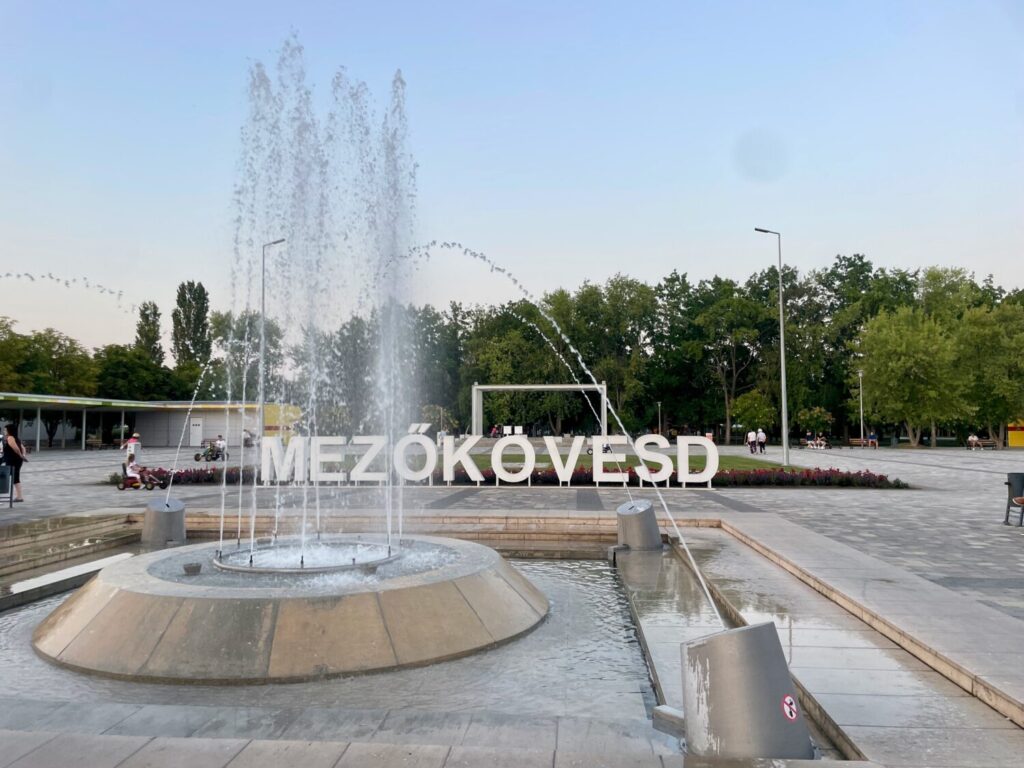
Where to Stay in Mezőkövesd: Hotels, Apartments and Holiday Homes
During our trip to Mezőkövesd, we stayed in a holiday home. Not because we particularly prefer this option, but simply because there aren’t many interesting hotels in the town centre. Most accommodations are near the Zsóry Thermal Bath.
In the centre of Mezőkövesd, it’s easier to find apartments and private houses (in Hungarian vendégház, literally ‘guest houses’), which are perfect if you want to visit the museums and the Hadas district on foot. We booked our accommodation online a few days before departure. It was clean, well-maintained, had private parking, and a central location, although, of course, it didn’t offer the same comforts as a hotel.
My first choice in Mezőkövesd would have been Zsóry Liget Camping & Resort. Unfortunately, no chalets were available for our dates. If you’re travelling in summer and this place interests you, I recommend booking in advance. Perhaps straight away, since free cancellation is available.
If you’re looking for a relaxing wellness stay, the Balneo Hotel Zsóry Thermal & Wellness is a four-star hotel with a spa, sauna, pools and all the facilities you need to enjoy a few peaceful days at the bath.
Visiting Mezőkövesd means discovering an authentic side of Hungary, where culture, craftsmanship, and relaxation come together, making it a perfect trip for both adults and children. Feel free to share in the comments if you enjoyed this article about Mezőkövesd and what inspires you most about this charming Hungarian town.
